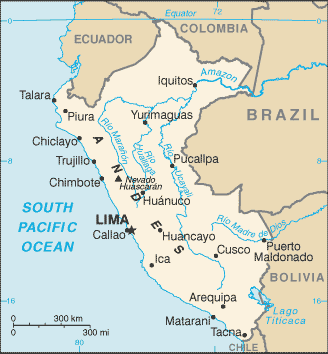 After a delay of a year beyond what was mandated by the law passed in November 2017, Peru has finally unveiled regulations for its new medical marijuana program. Now the activists who fought for the law say they will keep fighting for what has always been their central demand: the right to home cultivation by patient "associations."
After a delay of a year beyond what was mandated by the law passed in November 2017, Peru has finally unveiled regulations for its new medical marijuana program. Now the activists who fought for the law say they will keep fighting for what has always been their central demand: the right to home cultivation by patient "associations."
Officially, the clock stopped ticking in January 2018 for Peru's government to approve a regulatory regime for medical marijuana. That's when the 60-day deadline ran out under the law passed the previous November—following a hard-fought campaign by medicinal cultivators and their activist allies. But the process went into extra innings as lawmakers and bureaucrats hashed out the details. The fruits of this lengthy process are now finally official, as the regulations were approved by the executive branch on Feb. 23.
An 'important advance' —but the 'struggle continues'
The regulations took effect as they were published in El Peruano, the government's official register. The preamble to the eight pages of dense bureaucratic prose states that the aim of the regulations is to "guarantee the fundamental right to health and permit access, exclusively for medicinal and therapeutic use, to cannabis and its derivatives."
Congress member Alberto de Belaunde, who drafted the medical marijuana law in 2017, said in a statement: "We begin this day with good news: After a long wait, today the regulations for the medicinal cannabis law are finally published. They must be studied to assure that the best regulation has been adopted, but it is clearly a very important advance in this struggle." He offered an "homage to the mothers and all the activists who made this possible."
But he added: "The struggle continues, as we need to win permission for associated cultivation. We will soon present a new initiative in Congress to continue advancing."
"Associated cultivation" (cultivo asociativo) refers to the right of patients and care providers to join in associations to collectively grow their own medicine. The law passed in 2017 was ambiguous on this point, allowing cultivation by "public entities" such as universities or "laboratories"—with the latter undefined. It was hoped that this latter category, once defined in the regs, could include such patient associations. But there is no such provision in the newly published regulations.
Bureaucratic control
Instead, the regulations effectively hand control of every step in the process to big business and bureaucrats. "Production, importation and commercialization" is to be overseen by the Health Ministry's General Directorate for Medication and Drug Supply (DIGEMID). Research and product development is to be licensed by the National Health Institute, with only universities, registered pharmaceutical companies, and "public entities" considered for application. Cultivation within Peru is to proceed cautiously, initially with test plots closely managed by the Agriculture Ministry's National Institute of Agrarian Research (INIA). Most ominously, each of these activities must be closely coordinated with DIRANDRO, the feared Anti-Drug Directorate of the militarized National Police force.
Hearteningly, the regulations do allow for herbaceous cannabis in addition to extracts, tinctures and other such preparations. But it is only to be available through pharmacies, and only to registered users.
In October, de Belaunde announced that he was preparing a law to explicitly allow cultivo asociativo. With the failure of the new regulations to provide any recognition of such status, there is greater pressure for this legislation.
Mother courage betrayed
Ironically, the model for cultivo asociativo was the collective Buscando Esperanza (Seeking Hope), principally made up of mothers who were producing cannabis oil for their offspring suffering from epilepsy and other such ailments. When their operation in a Lima apartment was raided by the police in February 2017 and three members of the collective slapped with criminal charges, it sparked the public campaign for a medical marijuana law in Peru.
Buscando Esperanza co-founder Ana Álvarez, the mother of an epilepsy sufferer, especially became the public face of the campaign. She was personally on hand as an honored guest for the signing ceremony at the presidential palace when the law was passed. In April 2018, five months after the law's passage, charges were formally dropped against Álvarez and her two co-defendants—longtime Lima cannabis advocate Luis Gavancho and the medical doctor Juan Lock Arrunátegui.
But there is no place in the regulations for efforts like Buscando Esperanza, which gave impetus to passage of a medical marijuana law in the first place.
Gavancho, lead figure in the group Legaliza Perú, was reached for comment in Lima by Cannabis Now following publication of the regs. "There is no difference between the flower that they now seek to regulate and the flower that continues to be an illegal drug outside of the regulations," he said. "The cannabis flower has been, is, and will continue being the medicine of the people, whether it is prohibited or not."
Ana Álvarez expressed her determination to continue pressing for patient cultivation: "This will be a long road, but we will keep up the fight."
Cross-post to Cannabis Now
Graphic: Perry-Castañeda Library Map Collection







Recent comments
2 weeks 14 hours ago
5 weeks 6 days ago
9 weeks 6 days ago
10 weeks 4 days ago
20 weeks 4 days ago
24 weeks 4 days ago
25 weeks 5 days ago
25 weeks 5 days ago
46 weeks 6 days ago
51 weeks 1 hour ago